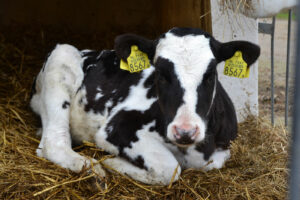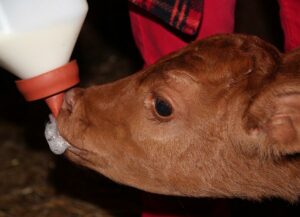Fernando Díaz
Methane is the main greenhouse gas generated by ruminants and represents a significant loss of gross energy (2–12%) for the animals. Therefore, mitigating enteric methane emissions from ruminants is beneficial from the point of environmental conservation and energy efficiency.
Recently, in order to reduce methane emissions from the animal industry, a new additive, 3-nitrooxypropanol (3-NOP), has been developed. This synthetic non-toxic compound inhibits the enzyme methyl-coenzyme M reductase, the enzyme that catalyzes the last step of methanogenesis in the rumen.
A recent study (Van Wesemael et al., 2019) carried out at the experimental farm of the Flanders Research Institute for Agriculture, Fisheries and Food, Melle, Belgium determined the effect of feeding 3-NOP on the enteric methane emissions and performance of lactating Holstein cows. Cows were housed in a freestall barn and were fed a forage mixture through feed bins and concentrates via feed stations located in the pens. In order to evaluate the best way to supplement the additive, the authors divided the cows in two groups, and they received the 3-NOP either blended with the forage or incorporated into a concentrate pellet. The additive was given at a dose of 1.6 g/cow per day. Another group of cows was unsupplemented.
Methane emissions were measured daily during the entire experimental period (10 weeks) using GreenFeed units. This is an automated head-chamber system that monitors methane and carbon dioxide mass fluxes from the breath of cows. It offers small quantities of feed to lure the cows to the systems multiple times daily, and as the animal visits the system, a fan system pulls air past the animal’s muzzle into an intake manifold, and through an air collection pipe where continuous airflow rates are measured.
The authors reported that both ways of feeding 3-NOP were effective in reducing the enteric methane emissions and no differences were found between supplementing routes. Compared with the no-additive group, methane production (g/day) was 25% lower in supplemented cows. Moreover, cows fed with 3-NOP produced less methane per kg of dry matter consumed (23.5 vs. 18.3 g) and per kg of milk produced (19.3 vs. 14.7 g) than unsupplemented cows.
Supplying 3-NOP did not affect total dry matter intake (20.0 kg/day), milk production (27.6 kg/day), or milk composition (4.19% fat & 3.56% protein). Interestingly, the additive reduced methane production; however, feed efficiency was not increased by additive addition (1.3 milk/intake).
In conclusion, feeding 3-NOP either blended with the forages or into concentrate mix is a promising strategy for lowering enteric methane emissions of lactating dairy cows.
References
- D. Van Wesemael, L. Vandaele, B. Ampe, H. Cattrysse, S. Duval, M. Kindermann, V. Fievez, S. De Campeneere, and N. Peiren. 2019. Reducing enteric methane emissions from dairy cattle: Two ways to supplement 3-nitrooxypropanol. J. Dairy Sci. 102:1780–1787.
- A. N. Hristov, J. Oh, F. Giallongo, T. Frederick, H. Weeks, P. R. Zimmerman, M. T. Harper, R. A. Hristov, R. S. Zimmerman, A. F. Branco. 2015. The use of an automated system (GreenFeed) to monitor enteric methane and carbon dioxide emissions from ruminant animals. J Vis Exp. 103: 52904.











